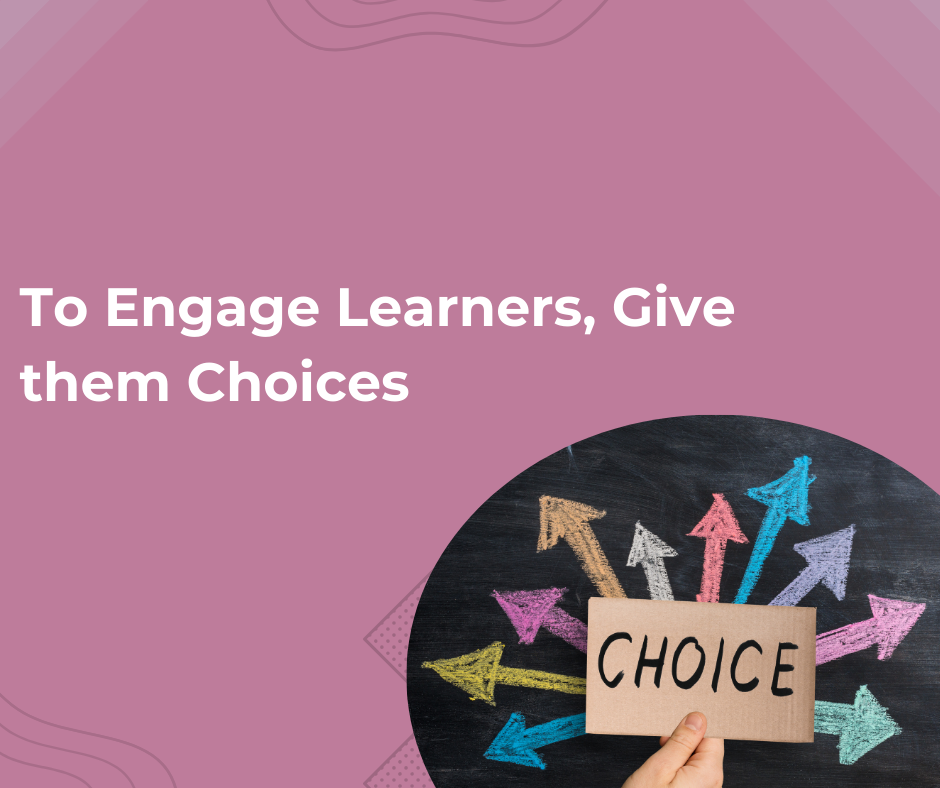Structure and Choice in Digital Education

Table of Contents
Coffee Shop and Learning Platforms
Imagine walking into a coffee shop early in the morning, hoping to kickstart your day with a quick caffeine fix. This isn't just any coffee shop, though—it prides itself on offering an unparalleled variety of coffee beans, brewing methods, and customisable options. As you approach the counter, the barista greets you with a smile and hands you a menu. But this menu isn't like the ones you're used to; it's more like an encyclopedia of coffee, with page after page of options.

At first, you're excited by the possibilities. Ethiopian or Colombian beans? French press, pour-over, or siphon? Milk alternatives, syrups, spices—the list goes on. However, as you flip through the menu, trying to make a choice, that initial excitement turns to overwhelm. The sheer number of decisions you need to make just to order a cup of coffee becomes paralysing. You start to question every preference you've ever had about coffee. Do I even know what I like anymore?
The minutes tick by, and you're no closer to making a decision. Other customers line up behind you, their impatience palpable. The barista offers help, suggesting their most popular blend prepared with a standard drip, but even this decision feels daunting. Should you trust their recommendation, or is there a better choice hidden in the menu that you're missing?
In the end, you step aside, letting others order while you try to decide. The freedom to choose anything has become a burden, making it impossible to choose anything at all. Eventually, overwhelmed and now running late, you order a simple espresso—the very first option you saw when you first looked at the menu.
This anecdote illustrates how too much choice, without a clear structure to guide decision-making, can lead to decision paralysis. In learning environments, as in coffee shops, the abundance of options can be overwhelming, highlighting the importance of providing a structured path to navigate through the possibilities.
Just as a organised menu with recommendations can help guide customers to a satisfying coffee experience, a clear learning path with guided choices can help learners effectively navigate their educational journey, making the process more enjoyable and less overwhelming.
Relevance of Choice for Autonomous Learning
Think about your coffee again - do you like it strong and concentrated, with a layer of creme on top or creamy with steamed milk and flavoured with syrups?
Just like it's important to have the option to choose the coffee you like, for learners, it's vital to have the choice in their learning.
Why?
Choice is a powerful motivator in learning because it taps into learners' intrinsic motivations and interests. When learners have the opportunity to make choices about what, how, when, and where they learn, they are more likely to engage deeply with the material, persist through challenges and become more autonomous and self-directed.
Deep dive
Autonomous learning, also known as self-directed learning, refers to the process in which individuals take the initiative, with or without the help of others, to diagnose their learning needs, formulate learning goals, identify resources for learning, choose and implement appropriate learning strategies, and evaluate learning outcomes (1) (2).
Choice supports autonomous learning by allowing learners to exercise agency, fostering a sense of ownership over their learning process. It ensures that the learning experience is personalised and relevant. This personalisation is key to enhancing learner satisfaction and outcomes, as it enables individuals to pursue paths that are most aligned with their personal and professional goals.
But now, imagine a learner coming to a new learning platform. There's so much interesting content, from digital coursebooks to audio to video to presentations, all relevant to their learning, and so many cool new features - all in one place. And they students have to choose where to start, what to read, where to go next, and what to watch.
This is where structure comes into play.
The Foundation of Structure: Guiding Learners Towards Success
One foundational theory supporting the need for structured learning environments is Cognitive Load Theory (CLT). This theory posits that learners have a limited capacity for processing information in their working memory. When information is structured and organised logically, it reduces the cognitive load on learners, making it easier for them to assimilate and retain new information. Research by Sweller (1988) and subsequent studies have shown that instructional designs that minimise extraneous cognitive load can significantly enhance learning effectiveness.
Deep Dive
Cognitive Load Theory (CLT), first introduced by John Sweller in the 1980s, is a theoretical framework that focuses on how information is processed and stored in human memory. The theory divides cognitive load—the total amount of mental effort being used in the working memory—into three distinct types: intrinsic, extraneous, and germane (4). Understanding these can inform the design of instructional materials that enhance learning and retention.
Intrinsic Cognitive Load
Intrinsic load refers to the complexity inherent in the material being learned. It is determined by the nature of the task or content itself and the learner's prior knowledge and ability to process the new information. Intrinsic load cannot be altered by instructional design; however, it can be managed by breaking complex information into smaller, more manageable segments. For example, rather than introducing an entire ecosystem in biology, instruction could start with individual organisms and progressively build towards the complexity of their interactions within an ecosystem. This segmentation allows learners to assimilate complex information without overwhelming their cognitive capacities.
Extraneous Cognitive Load
Extraneous cognitive load is generated by the manner in which information is presented to learners and includes any elements of instructional design that are not essential to the learning objective. These unnecessary elements can distract the learner and take up valuable cognitive resources that could be better used for processing relevant information. Extraneous load can be reduced by eliminating irrelevant content, avoiding overuse of decorative media, and using clear and concise explanations. For instance, a math problem presented with irrelevant story details may increase extraneous load; simplifying the context or removing unrelated elements helps learners focus on the mathematical concept rather than extraneous information.
Germane Cognitive Load
Germane cognitive load is the mental effort dedicated to the process of learning itself—creating and strengthening schemas in long-term memory. This type of load is beneficial and represents the work done by the brain to turn information into knowledge. Instructional strategies that promote germane load include the use of analogies to link new information to existing knowledge or encouraging learners to practice applying new concepts in different contexts. By doing so, learners actively integrate new information with what they already know, solidifying their understanding and making retrieval from long-term memory more efficient.
Now, let's see how a learning path that shows you how much you've learned and what's ahead helps reduce cognitive load and improves learning progression.
Reducing Extraneous Load
A well-defined learning path helps to reduce extraneous cognitive load, which is the load imposed by the way information is presented to the learner, rather than the complexity of the information itself. By clearly outlining the steps and stages of the course, learners spend less mental effort trying to figure out what to do next or determining the relevance of various pieces of information. This conservation of mental resources allows learners to focus more on the intrinsic cognitive load, which is the effort associated with understanding the content itself.
Enhancing Germane Load
Germane cognitive load is the effort put into creating a permanent store of knowledge, or schema construction. Simply said - putting the knowledge in the long-term memory. A clear learning path supports this by guiding learners through carefully sequenced activities and content that build upon each other in complexity and depth. This sequencing facilitates the integration of new information with existing knowledge structures, making the learning process more efficient and effective. By seeing their progress, learners can also identify specific areas of strength and weakness, allowing them to allocate their cognitive resources more strategically to areas that require further understanding or skill development.
Facilitating Goal Setting and Motivation
A visible progress indicator, like a progression track bar, within a clear learning path helps learners set achievable goals and monitor their advancement towards these goals. Goal setting is a powerful motivator and can significantly reduce the cognitive load by providing learners with a sense of direction and purpose. Knowing exactly what needs to be accomplished to progress to the next stage helps learners focus their efforts and reduces the mental strain associated with uncertainty and lack of direction.
Supporting Effective Time Management
With a clear learning path, learners can better manage their time and cognitive resources. Understanding the scope of the course and their progress allows learners to plan their study sessions more effectively, allocating appropriate amounts of time and mental energy to each segment of the course. This proactive management of cognitive resources prevents the feeling of being overwhelmed, which can significantly increase cognitive load and impede learning.
Obviously, structure is important. So is the choice. How can we combine the two in a digital learning environment?
The Best of Both Worlds
Combining a structured learning path with the element of choice on a digital learning platform can create an environment that is both directive and flexible, catering to the needs of a diverse learner base.
Imagine a digital learning environment for a complex subject like Organic Chemistry. OK, it's complex for me.
On the first login, each student is prompted to take a pre-assessment designed to estimate their current understanding of key concepts, such as atomic structure, chemical bonding, functional groups, and nomenclature. Yes, I had to google those.
Based on the results of this pre-assessment, students get the following options to choose from:
Tailored Content Recommendations
How this works - based on their pre-assessment, students receive the path with different levels of difficulty. They can choose and select:
Atom Adventurers (for beginners): Students who show gaps in foundational knowledge are directed to the introductory chapters that reiterate basic concepts. They receive a learning path that starts with "The Basics of Organic Structures" and "Introduction to Hydrocarbons" to build a solid foundation before moving to more complex topics.
Molecule Mavericks (for intermediate learners): Those with a decent grasp of the basics but who struggle with intermediate concepts are steered towards chapters that focus on areas like "Stereochemistry" and "Reaction Mechanisms." They might also be given supplemental interactive exercises that provide additional practice in these areas.
Reaction Rangers (for advanced learners): Students who perform well on foundational and intermediate concepts but miss questions related to advanced topics are directed to later chapters in the textbook that cover "Complex Reaction Mechanisms" and "Synthetic Pathways." They are also encouraged to engage with advanced simulations that depict complex chemical reactions and synthesis processes.
Optional Deep Dives
All students, regardless of their pre-assessment scores, have the option to explore "In-Depth Topic Modules." These are special sections of the textbook or additional materials for those who are either particularly interested in a specific topic or who want to challenge themselves beyond the standard curriculum.
Btw, have you noticed Deep Dives in this article?
Just-in-Time Resources
As students progress through the recommended chapters, they receive "Just-in-Time" resources based on their interactions. For example, suppose a student hesitates or needs help with a practice question on alcohols and phenols. In that case, the get a targeted mini-lesson or an animated video that explains these compounds in detail.
This approach ensures that all students, regardless of their starting point, are provided with a structured yet flexible path through the textbook and accompanying materials. The choices they make are informed by their demonstrated needs and interests, allowing for a personalised and efficient learning experience that adapts to their individual pace and understanding.
Project-Based Learning Options
One of my favourites is a choice of projects or challenges based on real-world scenarios. Now, imagine the learner is in their chemistry course, and this is the learning path for their learning (looking forward to some feedback from a chemist - ChatGPT created these challenges):
Week 1-2: Foundations of Chemistry
- Core Learning: Introduction to basic concepts such as atomic structure, periodic table, chemical bonds, and reactions.
- Challenge/Project Options:
- Option A: Create a detailed infographic explaining periodic trends and their implications in real-world applications.
- Option B: Conduct a virtual lab simulation to observe the different types of chemical bonds and write a report on the findings.
Week 3-4: Organic Chemistry Essentials
- Core Learning: Study of carbon compounds, functional groups, and basic organic reactions.
- Challenge/Project Options:
- Option A: Model various organic molecules using a molecular kit or software and present their 3D structures and properties.
- Option B: Develop a concept map that links functional groups to their respective chemical reactions and uses.
By integrating these elements, digital learning platforms can cater to individual learning preferences and needs while maintaining a coherent structure that guides the educational experience. This approach not only enhances engagement and satisfaction but also promotes the development of self-directed learning skills.
Key Takeaways:
- Choice Overload: Just as an extensive coffee menu can overwhelm customers, too many unstructured options in a learning platform can lead to decision paralysis, affecting learners' ability to make progress.
- Importance of Structure: A well-defined learning path, similar to a curated coffee menu, can help learners navigate their educational journey, reducing cognitive overload and enhancing the learning experience.
- Relevance of Choice for Motivation: Offering learners choices within a structured framework taps into their intrinsic motivations, making the learning process more engaging and personalised, much like choosing a preferred coffee blend enhances the drinking experience.
- Cognitive Load Theory in Education: The article underscores the significance of managing cognitive load through structured learning paths, which help focus learners' mental resources on assimilating new information effectively.
- Balancing Structure and Choice: The ideal digital learning environment combines a clear, structured learning path with the flexibility of choice, allowing learners to pursue their interests while maintaining direction and focus, akin to a coffee lover finding their perfect cup in a well-designed menu.
More about the topic:
(1) Benson, P. (2001). Teaching and researching autonomy in language learning. London: Longman.
(2) Holec, H. (1981). Autonomy and foreign language learning. Oxford: Pergamon Press.
(3) Dörnyei, Z. (2005). The psychology of the language learner: Individual differences in second language acquisition. Mahwah, NJ: Lawrence Erlbaum.
(4) de Jong, T. (2010). Cognitive load theory, educational research, and instructional design: some food for thought. Instr Sci 38, 105–134. https://doi.org/10.1007/s11251-009-9110-0
(5) Sweller, J., van Merriënboer, J.J.G. & Paas, F. (2019). Cognitive Architecture and Instructional Design: 20 Years Later. Educ Psychol Rev 31, 261–292.



